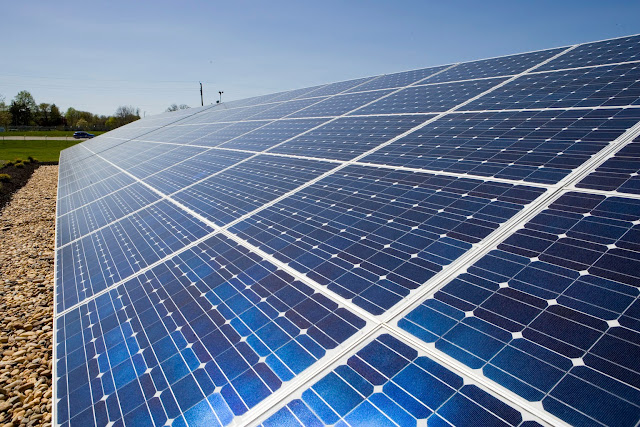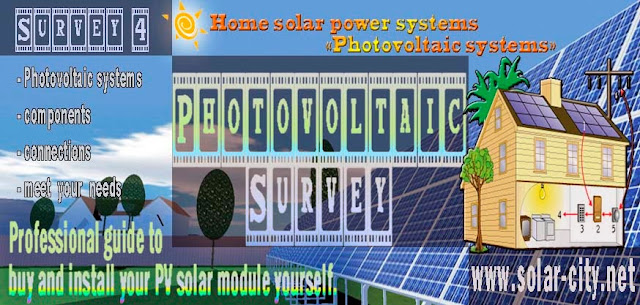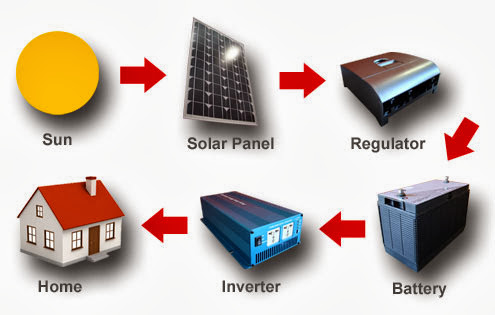Photovoltaic effect is a direct conversion of light into electricity, which as the name implies (photo meaning "light" and voltaic meaning "electricity") and this means converting sunlight directly into electricity. That was the brief definition of the Photovoltaic Effect.
- Photovoltaic materials:
In order to get the photovoltaic effect we add some impurities to silicon.
First type of silicon used:
Consider silicon with some atoms of phosphorous here and there, maybe one for every million silicon atoms. Phosphorous has five electrons in its outer shell, not four. It still bonds with its silicon neighbor atoms, but in a sense, the phosphorous has one electron that doesn't have anyone to hold hands with. These electrons, called free carriers. The resulting silicon is called N-type ("n" for negative) N-type doped silicon is a much better conductor than pure silicon.
Second type of silicon used:
Consider silicon is doped with the element boron, which has only three electrons in its outer shell instead of four, to become P-type silicon. Instead of having free electrons, P-type ("p" for positive) has free openings and carries the opposite (positive) charge.
So Photovoltaic materials used to get photovoltaic effect are P-type & N-type silicon.
- Photovoltaic energy:
Sunlight contains packets of energy called 'photons'. When the sunlight strikes the N-type silicon layer, the energy that photons carry makes some electrons free and they move. They move to the P-type layer causing electrical current in the circuit. The electrical energy that we get with photovoltaic effect is called photovoltaic energy.
- What are photovoltaic cells :
Photovoltaic cells are the units which is connected together to form a solar panel and we can say that a photovoltaic cell is the building unit in the solar system which made of photovoltaic materials and makes a photovoltaic effect under the sun to give solar energy.
- Photovoltaic array:
 Photovoltaic array is a combination of solar panels connected together.
Photovoltaic array is a combination of solar panels connected together.
Photovoltaic panel or module is a combination of solar cells which is connected together in series or in parallel and collected in one frame. While there are many brands on the market, there are essentially just three types of technologies involved in making a solar panel – monocrystalline, polycrystalline and thin film.
- Photovoltaic materials:
In order to understand the Photovoltaic effect, we need to know the materials which photovoltaics are made of.Photovoltaic materials are special materials called semiconductors such as silicon, which is currently used most commonly.
In order to get the photovoltaic effect we add some impurities to silicon.
First type of silicon used:
Consider silicon with some atoms of phosphorous here and there, maybe one for every million silicon atoms. Phosphorous has five electrons in its outer shell, not four. It still bonds with its silicon neighbor atoms, but in a sense, the phosphorous has one electron that doesn't have anyone to hold hands with. These electrons, called free carriers. The resulting silicon is called N-type ("n" for negative) N-type doped silicon is a much better conductor than pure silicon.
Second type of silicon used:
Consider silicon is doped with the element boron, which has only three electrons in its outer shell instead of four, to become P-type silicon. Instead of having free electrons, P-type ("p" for positive) has free openings and carries the opposite (positive) charge.
So Photovoltaic materials used to get photovoltaic effect are P-type & N-type silicon.
- Photovoltaic energy:
Sunlight contains packets of energy called 'photons'. When the sunlight strikes the N-type silicon layer, the energy that photons carry makes some electrons free and they move. They move to the P-type layer causing electrical current in the circuit. The electrical energy that we get with photovoltaic effect is called photovoltaic energy.
- What are photovoltaic cells :
Photovoltaic cells are the units which is connected together to form a solar panel and we can say that a photovoltaic cell is the building unit in the solar system which made of photovoltaic materials and makes a photovoltaic effect under the sun to give solar energy.
- Photovoltaic array:
 Photovoltaic array is a combination of solar panels connected together.
Photovoltaic array is a combination of solar panels connected together.Photovoltaic panel or module is a combination of solar cells which is connected together in series or in parallel and collected in one frame. While there are many brands on the market, there are essentially just three types of technologies involved in making a solar panel – monocrystalline, polycrystalline and thin film.
Photovoltaic
cells are made of special materials called semiconductors such as
silicon, which is currently used most commonly. - See more at:
http://www.solar-city.net/2013/10/what-is-photovoltaic-effect_7.html#sthash.lXIq2P6v.dpuf
which as the name implies (photo meaning "light" and voltaic
meaning "electricity"), convert sunlight directly into electricity. - See more at: http://www.solar-city.net/2013/10/what-is-photovoltaic-effect_7.html#sthash.lXIq2P6v.dpuf
Read More »





































